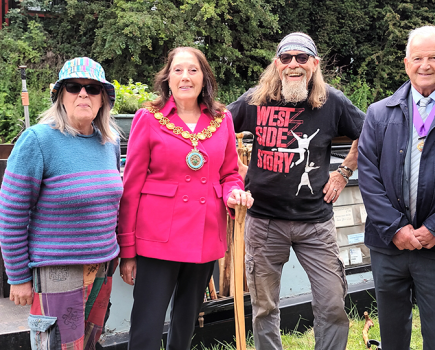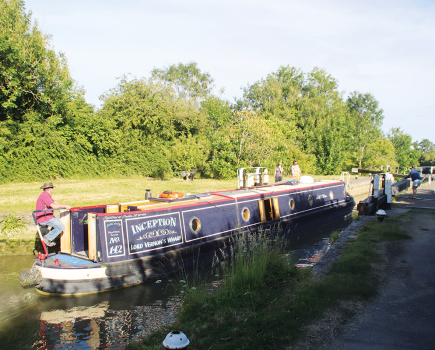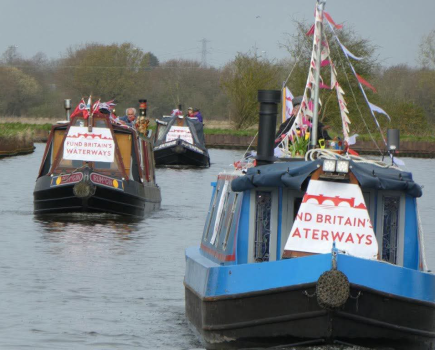Two short but interesting river navigations connect the Thames and Regents Canal via London’s Olympic venues to the attractive countryside of North Essex and Hertfordshire

If waterways history had worked out differently, the Lee and Stort navigations could have been part of a navigable route to Cambridge, linking the Fenland waterways directly to London’s Docklands and creating all sorts of interesting through routes and circuits. However the old problem of lack of finances stepped in, and the waterway from the Stort to Cambridge was never constructed.
But although this left us with two dead-end river navigations, it’s well worth cruising from the main canal system through London to explore them. The River Lee becomes navigable at Hertford and then passes through the towns of Ware, Stanstead Abbots and Broxbourne. Then in the Lee Valley Regional Park it provides a green passage through Cheshunt, Waltham Abbey and Enfield to the Olympic Park before joining the River Thames at Limehouse. And the River Stort Navigation begins at Bishop’s Stortford, passing through Sawbridgeworth and Harlow on its 14-mile descent to a junction with the Lee just north of Broxbourne.
Boaters can reach the Lee via the Regent’s Canal and the Hertford Union Canal, or alternatively via the tidal Thames, entering the navigation at Limehouse Basin. Formerly known as Regent’s Canal Dock, this opened in 1820 and covered ten acres of water with four acres of quayside. It was active until the 1960s handling produce and raw materials brought by ship from all over the world which was then distributed by canal; meanwhile coal and other commodities were brought by canal from the Midlands.

Today, Limehouse Basin is a marina with extensive moorings, surrounded by modern housing.
Leaving the basin via the Limehouse Cut takes you to Bow Locks, a link to the tidal Bow Creek which provides the third (and least used) way of reaching the Lee Navigation. This is the real beginning of the Lee Navigation, and the next landmark is Three Mills with its fine complex of buildings including a restored former tidal mill.
Soon afterwards you will see one of the entrances to the Bow Back Rivers, a complex network of channels which are now transformed into the Olympic Park waterways. This former derelict area became the location for the 2012 Games, and many of the specially constructed buildings have survived including the main Olympic Stadium which is now home to West Ham United football club. The proposed full reopening of the Olympic Park waterways to visiting boats was delayed from spring 2017, because of restoration work on Carpenters Road Lock taking longer than originally planned, but an opening is planned for August Bank Holiday.

Back on the Lee main line, Old Ford Locks, like most of the locks on the Lower Lee, are paired and mechanised. Hackney Marshes provide a welcome area of greenery in what is an intensely built up region . The Lee Valley Ice Centre at Lea Bridge Road is followed by Walthamstow Marshes, another green open space. Then comes a series of reservoirs which extend all the way to Enfield. This section of navigation is often busy with canoeists and rowers. At Springfield Park, the Lee Valley Marina faces a waterside cafe very popular with visitors in the summer months.
The Markfield Beam Engine building can be seen a little further along towards Tottenham. Originally installed in 1886 to pump sewage, the beam engine has been restored and is occasionally open to the public. It is situated in a park surrounded by gardens.
After Tottenham Lock the navigation follows a straight course flanked by reservoirs on one side and industry on the other. The next point of interest is at Pickett’s Lock where the Lee Valley Leisure Centre can be seen beyond the lock. It includes indoor and outdoor athletics centres, swimming pool, multi-screen cinemas, restaurants and bars. Several of Britain’s Olympic athletes used the athletics centre for training.

Ponders End Lock has moorings and a large waterside pub. This is followed by an industrial section which once extensively used the navigation but has now turned its back on the water in favour of road transport. At Enfield Lock there is a Canal & River Trust maintenance yard and a pub. Stop here to visit the Enfield Island Village, built on the site of the now redundant Royal Small Arms Factory. Some of the original buildings which made over five million Lee Enfield rifles have survived.
Passing the noisy M25 motorway, you arrive at Waltham Town Lock, a good place to stop for there’s lots to see in this area. Waltham Abbey town centre with all its shops and a market is just a short walk from the navigation. The beautiful Abbey dates back to Norman times and remains of King Harold are reputed to be buried here. There is a memorial to King Harold in the delightful gardens which are divided by the meridian line. Waltham Abbey is also the site of the Royal Gunpowder Mills (see inset) – but its future is in doubt, so visit it soon.
A more recent addition to the Waltham Abbey scene is the Lee Valley White Water Centre (see inset) adjacent to Waltham Town Lock.

The navigation now continues northwards for four miles in a straight line to Broxbourne passing Cheshunt with a series of lakes on both sides of the waterway. At Broxbourne the navigation takes a sharp turn eastwards by a busy boatyard situated on a short arm which has a hire fleet and public trip boats. There is also a waterside pub with a garden and Broxbourne town centre is just a short walk away.
There is now a definite feeling of the countryside as the navigation reaches Carthagena Lock with its pretty flower garden. Lakes and pools accompany the navigation to Dobbs Weir, with its lock and popular pub surrounded by woodland. Immediately after Feildes Weir Lock, you will see to your right the entrance to the River Stort Navigation.
At Rye House stands another pub with a waterside garden. Behind it is a karting stadium (where racing driver Lewis Hamilton got his first taste for competitive driving), a nature reserve and the historical Rye House Gatehouse that dates back to 1443 (see inset).

Next come the twin villages of Stanstead Abbotts and St Margaret’s (one on each side of the river) which have all shopping facilities close to the navigation. This is a busy boating centre with a marina, plus a pub with a large waterside garden next to the road bridge.
This is followed by a lovely quiet reach with nature reserves in flooded quarries backed up by wooded hills. There is just one lock at Hardmead and the only bridges are footbridges.
Things get a bit busier at Ware, where the navigation cuts through the town centre. There are several excellent pubs and the 18th century gazebos make an interesting waterside feature. Ware was once known as ‘The Granary of London’ because of its maltings and direct links to the capital. Most of the mills and maltings that are still standing have been converted to new purposes.

Once past the A10 road viaduct, the navigation passes through a section of attractive countryside known as the Meads before reaching Hertford Lock. A line of moorings leads into Hertford where the head of navigation is just beyond the Old Barge pub. Moor there and explore Hertford, an interesting town centre with the remains of a medieval castle.
Back at Feilde’s Weir Lock, we turn on to the 14-mile River Stort Navigation. The river is much narrower than the Lee, and is mostly rural in aspect. The first two locks are overlooked by wooded hills, then the navigation reaches Roydon Mill where there is a very large 315 berth marina reached by a new lock from the navigation. Combined with a hotel, holiday chalets, restaurant, bar and a caravan site, this is known as Roydon Marina Village, and has become waterside holiday resort.
It’s back to nature after Roydon Lock, when the navigation passes through the Hunsdon Mead nature reserve. This 68 acre grassland site has a superb display of wildflowers in the summer months.

The mill at Parndon Mill Lock once produced flour which was carried by boat into London. Nowadays, it has become an art centre with studios for painting, sculptors and architects.
The navigation passes around the edge of Harlow where you will see a huge climbing wall just before Burnt Mill Lock. There is a pub and restaurant by the lock, while nearby Moorhen Marina has all facilities for boaters . This is followed by a wooded section leading to Harlow Mill Lock with yet another pub, restaurant and hotel in a converted mill building.
The navigation continues through pleasant woodland to Sawbridgeworth. Beyond Sheering Mill Lock is a pleasant modern waterside housing development followed by maltings now converted to businesses and apartments, with the town centre just a short walk away.

After Sawbridgeworth the navigation twists and bends before reaching Tednambury Lock. Hallingbury Marina is located on a short arm formed from a former millstream above the lock. At the end of the arm is Little Hallingbury Mill which is an impressive building built as a corn mill in 1874 and now converted to a hotel and restaurant.
The navigation continues on its peaceful way in pleasant open countryside passing through the occasional lock. Rushey Mead nature reserve is worth a visit and can be seen between Twyford and South Mill Locks. The wetland areas are popular with waterfowl and the grassland sections have a fine display of wildflowers in the summer season.
After South Mill Lock the waterway enters Bishops Stortford where the end of navigation is close to the town centre.

For 150 years from the opening of the River Stort Navigation in 1769, huge tonnages of grain and malt were loaded here and shipped to London and beyond. Today, most of the old maltings, granaries and timber yards have gone and their sites have been converted into housing. But with shops, pubs, a market and entertainment centres within easy reach, plus the Rhodes Art Complex (Cecil Roads was born near here) and Bishop’s Stortford Museum, it’s a fine place to visit and stock up with provisions before returning to the River Lee.
Must see

– The Royal Gunpowder Mills at Waltham Abbey was a large complex which had its own canal system for moving unstable raw explosives between various production buildings within the site. It was active for over 300 years; it is now a 175 acre museum where you can learn all about the history of explosives and sometimes watch civil war re-enactments.
– The Lee Valley White Water Centre was built to host the canoe and kayak slalom events at the 2012 Olympics. It is now open to the public as a white water experience on the 300 metre slalom course. Joe Clarke, 2016 Olympic gold medallist in the men’s slalom did much of his training at the centre which has a cafe with a terrace where you can watch all the action.

– Rye House Gatehouse was attached to a fortified mansion that was the stage for the Rye House Plot of 1683. An extremist Whig group plotted to kill King Charles II and his brother as they returned from the races at Newmarket. The plot was foiled and nine men and a woman were subsequently executed. You can find out all about it in the preserved gatehouse.




Image(s) provided by:
Derek Pratt







